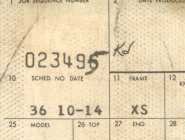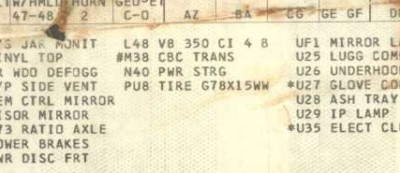-
Build Sheet
The build sheet is the best proof of what options a vehicle had from the factory and, therefore, possessing this piece of paper can add value to a first generation Monte Carlo. A fairly low optioned Monte may not be worth too much more with a build sheet. On the other hand, for a car that has desirable or rare options, a build sheet can add significant value. Note that only U.S. assembly plants used full size build sheets. Canadian assembly plants used a much smaller slip of paper simply with 3 digit RPO codes on them with no descriptions.

How to Find Your Build Sheet
Build Sheets can be found in many different places in your car. The two most common places are the on top of the gas tank and under the seats. The gas tank is extremely common but the paper is subject to the elements and may not be in great condition. Some may not be legible at all after several decades. Under the seat they will usually be placed between the foam and the springs and one must be careful removing it for it to stay intact. Some are stuffed into the corners of the seat frame making it a little more difficult to remove in one piece. If you do find one, make sure that it is for your vehicle, sometimes build sheets end up in the wrong car.
Other possible locations include:
Inside the door panels
Under the dash pad
Inside the fender
Under the carpetThere could be as many as three build sheets in a car located in different places but, in some cases, there may be no build sheet at all. For example you will not find a build sheet in a car built at the Flint plant.
How Build Sheets End Up in a Car
The build sheet was used on the assembly line to indicate what parts to put on the car. They were supposed to be thrown out by workers on the assembly line but many found it easier just to hide it in the car somewhere rather than walk over to a garbage can. Some plants were more strict of these rules and cars from those plants may not have a build sheet in them.
Build Sheet Contents
The build sheet will have the vehicle identification number and all the options and components the car will have from the factory. Below are a few blown up sections of the build sheet.
Sequence Number and Date
The sequence number and scheduled build date are located in the top left corner
Trim and Paint Code
Also in the top left corner under the date is the model number, trim code (interior color and seat type) paint code and vinyl top code.
Standard Equipment and Options
The area in the top-middle of the page will show codes for some of the basic components installed on the car.
Optional Equipment
The middle section of the page is where the major option codes and descriptions are located. The blown up section here shows what engine was installed among other options. The "*" in this case signifies that the item is standard equipment and the "#" signifies that it is a body shop item.
The GM Dealership
The bottom left corner of the build sheet describes the dealership that the car was ordered for.
Manufacturing Plant
The bottom-middle has the plant name and location





